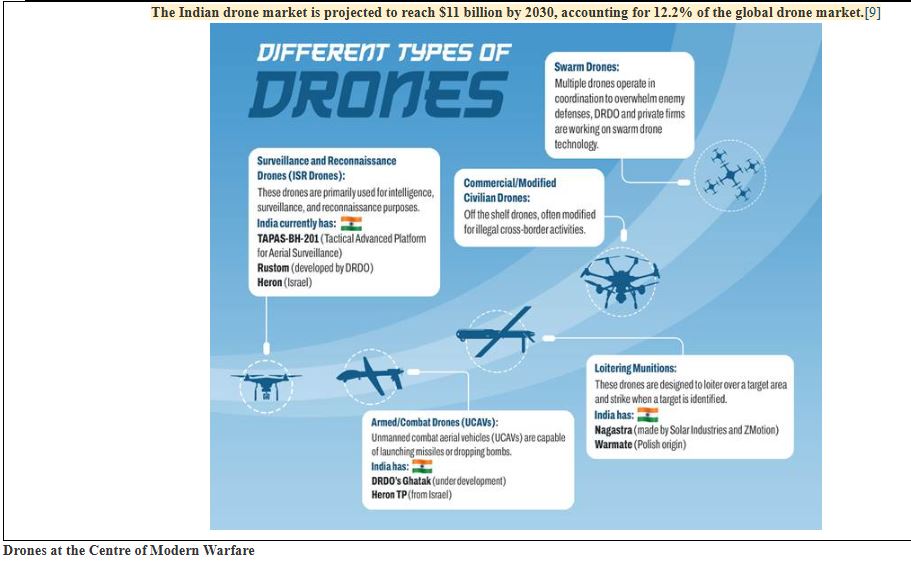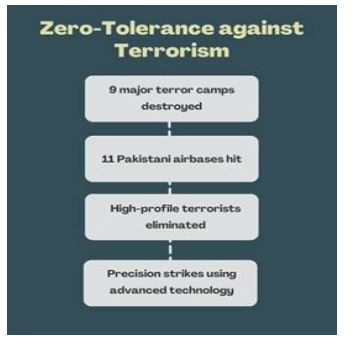Inside Operation SINDOOR: Operation SINDOOR marked a watershed moment in India’s counter-terrorism doctrine, showcasing a blend of military precision, technological self-reliance, and diplomatic mastery. This multi-faceted operation successfully neutralised terrorist threats, deterred potential aggression from Pakistan, and decisively enforced India’s zero-tolerance policy towards terrorism. Importantly, the operation was conducted with strategic restraint, a factor that helped garner international support.
A critical element of India’s technological superiority was demonstrated when the Indian Air Force, using Rafale jets, SCALP missiles, and HAMMER bombs, successfully bypassed and jammed Pakistan’s Chinese-supplied air defence systems. This complex mission against defended targets was completed in just 23 minutes.

Key technologies and systems deployed during Operation Sindoor included:
Proven Air Defence (AD) Systems: Battle-tested platforms like the Pechora, OSA-AK, and Low-Level Air Defence (LLAD) guns.
Indigenous Systems: Notably, the Indian-developed Akash missile system, which delivered an exceptional performance.
Synergistic Tri-Service Operation: India’s Air Defence, integrating assets from the Army, Navy, and primarily the Air Force, operated with outstanding coordination.
Integrated Command and Control: The Indian Air Force’s Integrated Air Command and Control System (IACCS) seamlessly networked these diverse elements, providing the crucial net-centric operational capability essential for modern warfare (i.e., a highly interconnected system for superior situational awareness and response)
.
Air Defence systems function by detecting, tracking, and neutralising threats using an integrated network of radars, command centers, artillery, and missiles launched from both air and ground platforms.
The AKASH is an indigenous Short-Range Surface-to-Air Missile system designed to protect critical areas from air attacks. It can engage multiple targets simultaneously, either in coordinated group mode or autonomously, and features advanced Electronic Counter-Counter Measures (ECCM) to resist enemy jamming. The entire system is mobile.
ISRO’s Crucial Contribution to National Security
Underscoring the role of space technology, ISRO Chairman V. Narayanan stated on May 11 that at least ten satellites are continuously working around the clock for strategic purposes. He emphasized that “to ensure the safety and security of the citizens… the nation has to serve through its satellites. It has to monitor its 7,000 km seashore areas… [and] the entire Northern part continuously. Without satellite and drone technology, the country can’t achieve that.”

What Operation Sindoor Achieved
Nine Terror Camps Eliminated: India destroyed nine major terrorist launchpads in Pakistan and Pakistan-occupied Jammu and Kashmir (PoJK), targeting facilities of Lashkar-e-Taiba, Jaish-e-Mohammed, and Hizbul Mujahideen. Over 100 terrorists were neutralised.
Cross-Border Precision Strikes Redefined Engagement: India struck deep into Pakistani territory, including Punjab province and Bahawalpur—areas previously considered off-limits. This sent a clear message: terror originating from any territory will be met with a response.
A New Strategic Red Line: The operation established that state-sponsored terrorism will invite a visible and forceful Indian response, marking a shift from deterrence by denial to deterrence by direct action.
No Distinction Between Terrorists and Sponsors: India held both terrorists and their state backers accountable, striking them concurrently and ending the impunity previously enjoyed by many Pakistan-based actors.
Pakistan’s Air Defence Weaknesses Exposed: The successful 23-minute IAF mission, bypassing and jamming Pakistan’s air defences, highlighted India’s technological edge.
India’s Air Defence Superiority Demonstrated: India’s multi-layered air defence, featuring indigenous systems like Akashteer (an Air Defence Control & Reporting System), successfully intercepted hundreds of incoming drones and missiles, also showcasing India’s growing capability as an exporter of advanced defence systems.
Precision Strikes Minimised Escalation: By focusing strictly on terror-related and supporting military targets and avoiding civilian casualties, India maintained its zero-tolerance policy for terror while preventing a full-scale war.
Key Terror Commanders Eliminated: Several high-profile terrorists on India’s most-wanted list, including Yusuf Azhar, Abdul Malik Rauf, and Mudassir Ahmad (linked to the IC-814 hijack and Pulwama blast), were neutralized, crippling critical terror networks.
Significant Damage to Pakistani Military Installations: On May 9–10, India conducted strikes against 11 airbases of a nuclear-armed nation in a single operation, reportedly destroying 20% of Pakistan’s air force assets. Bhoolari Airbase suffered heavy casualties, including the death of Squadron Leader Usman Yusuf and the destruction of key fighter jets.
Coordinated Tri-Service Prowess: The seamless coordination between the Indian Army, Navy, and Air Force demonstrated India’s maturing joint military operational capabilities.
A Clear Global Message: India asserted its sovereign right to self-defence without needing external permission, warning terrorists and their sponsors that they cannot hide and that any retaliation by Pakistan would be met with a decisive Indian counterstrike.
Widespread International Support: Unlike past conflicts, numerous global leaders supported India’s actions, reflecting India’s enhanced global standing and effective narrative management.
Kashmir Narrative Successfully Reframed: Operation Sindoor’s precision and clear counter-terrorism focus ensured that India’s actions were achieved.
Why It Matters
Operation SINDOOR marks the shift from strategic restraint to calculated retaliation. It’s not just about hitting back, but doing so on India’s terms, with precision, purpose, and power — militarily, economically, and diplomatically.
Also Read | PM Modi to Pakistan: No talks till terror ends, PoK is the only agenda










What is APAAR ID? CBSE Makes It Mandatory for Class 10 & 12 Board Exam Registrations
Will PM Modi’s GST Reforms Will Be the ‘Diwali Gift’ that Boosts Your Savings?
US Imposes New Tariffs on India, Trump Warns of More ‘Secondary Sanctions’